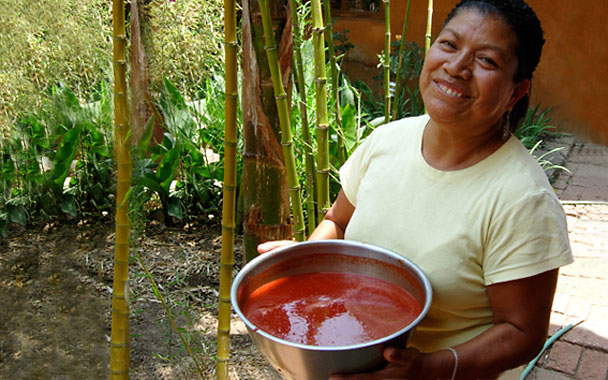I listened while Arminda Flores went over the fiesta menu with our friend Emily Hartzog, founder of Operacion Michoacán, a clinic in Patzcuaro, Mexico, which provides medical services to the indigenous Purepechan people. The fiesta was a fundraiser for the clinic, and the more I heard, the more I wanted to be involved. My husband and I were in town for a much-needed vacation, and I’m always in the mood to cook, so I offered to help.
An ebullient woman of wide smiles and vast energy, Arminda doubles as the clinic’s PR person, local good spirit, and mistress of a nearby bed-and-breakfast called Casa Santiago. She’s also a keeper of Purepechan traditions who happens to be married to an American.
The meal, to be prepared by various Purepechan women, would include a mole to be served over red rice rather than chicken or turkey. There would be tamales and also placeros, regional enchiladas in which tortillas are dipped into red chile, folded, and served with grilled chicken on the side instead of within. Pozole was on the menu, too, and there was something called churipo—a beef stew.
This last dish caught my eye, mostly because it featured the local tamales called cornudos, which have no filling and are shaped like pyramids. My husband and I had eaten them earlier, in a café where they were served with crema and a sharp, crumbly cheese. They are oddly bland and interesting at the same time, so when Arminda said I could help with the churipo preparation, I jumped.
In her outdoor kitchen, an enormous pot of beef had been simmering over a wood fire for several hours. Arminda reached into the pot, extracted a piece, took a bite, and declared it done. Because she isn’t very tall and the pot was very high, she climbed up on a stool then scooped out the meaty bones with a long-handled dipper and dropped them into a large, soot-covered clay pot. With the meat out of the way, she tasted the broth, found it flat, threw in a handful of salt, then another, and tasted again. She nodded her satisfaction, added more wood to the fire, and then we crossed the courtyard to her indoor kitchen, where bags of red potatoes, pale green zucchini, chayotes, stubby carrots, and green beans—all bought that morning at the market in Patzcuaro—awaited us. We peeled what needed to be peeled, halved the carrots and zucchini, left the potatoes whole, only tipped the green beans, and cut the chayotes into large pieces. Everything went into a big tub and was hosed off in the garden.
Then we tackled a huge pile of long, red, leathery ancho chile pods, pulling off the stems, opening them up, shaking out the seeds, and pulling off the large sticky veins before plunging them into a bowl of water to rinse off the dust. After they simmered in water for half an hour, Arminda’s niece puréed and strained them, making a slurry of pure-red chile.




 Pinterest
Pinterest


